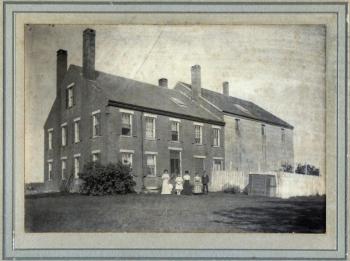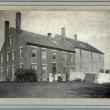Ladies of the Old Jail: Women who called the 1839 Jailer’s house home
It was Dec. 3, 1838 when the Jailer’s house, a wooden structure attached to the granite stone jail, burned in Wiscasset.
“Both Samuel Holbrook, the jailer at the time of the fire, and Benjamin Burgess, his successor, were forced to rent housing while the new jailer’s house was built.” So wrote Prescott Currier in his book "The Jails of Lincoln County, 1761-1913." What Mr. Currier did not expand upon was the state of Mrs. Holbrook’s mind and disposition after watching her possessions go up in flames. Although relief is assumed in knowing that her children were safe and had escaped injury.
The new jailer’s house was completed in September 1839. By then, Mr. Holbrook had left his position as jailer, which happen in May of that year, and Benjamin Burgess was hired to begin immediately following Mr. Holbrook’s last day. Mrs. Burgess was the first lady to take up residence in the new house – hers was the first decorative touch.
For over 70 years the stately brick house saw jail keepers come and go, one staying several months only, but most staying on the job for a least a year or two; Seth Patterson, who was jailer at three different times, held the position for 15 years in his last term. Most of these men were married. The names, Levina (Lavinia) Burgess, Harriet Trundy, Martha Webber, Mary Charlotte Albee, Laura Patterson, Mahela Hodgdon, Mary Boynton, are among those of the women whose husbands had the care of the Wiscasset Jail and its prisoners from 1839 to 1913.
There were four major shifts in ladies’ fashion during the same time period. The skirts of ladies gowns changed widths approximately every 20 years (other details changed more frequently). The halls and rooms of the jailer’s house would have been filled with the swishing of ladies skirts, for hemlines generally didn’t start to rise noticeably above the ankle until around 1913.
It is said that any wife who lived at the jail was to be cook for the prisoners. Mr. Currier noted in his book, that any jailer who did not take up residence in the jailer’s house had his pay adjusted to less that the slated amount. It would be interesting to know if husband and wife sat down once a week to plot out the meals to be cooked for that week. How much housekeeping of the cells, prisoners’ laundry and such would fall to the jailer’s wife?
A curiosity presently on display today in the kitchen of the Old Jail and Museum is a menu donated by the family of John D. Dow, jailer from 1906-1910. This menu was noted to have been used from 1904 to 1911. The cook who set this assortment of dishes in place was not recorded. It is easy to see that a large amount of wood was required for the kitchen oven, as gingerbread and biscuits were required all seven days of the week. Soup was a staple for four days, with meat being provided twice a week and fish once a week.
Perhaps future research will provide more details on the daily lives of the wives of Lincoln County jail keepers.
March is National Women’s Month and the Lincoln County Historical Association is celebrating by sharing the lives of women who lived in Lincoln County during the 18th and 19th centuries. Today, the Museum and Old Jail in Wiscasset is one of three historic sites under the care of the Lincoln County Historical Association, a nonprofit organization that also provides stewardship for the 1754 Chapman-Hall House in Damariscotta and the 1761 Pownalborough Court House in Dresden.
For more information about LCHA, visit www.lincolncountyhistory.com and the Facebook page, Lincoln County Historical Association Maine.
Event Date
Address
United States





















